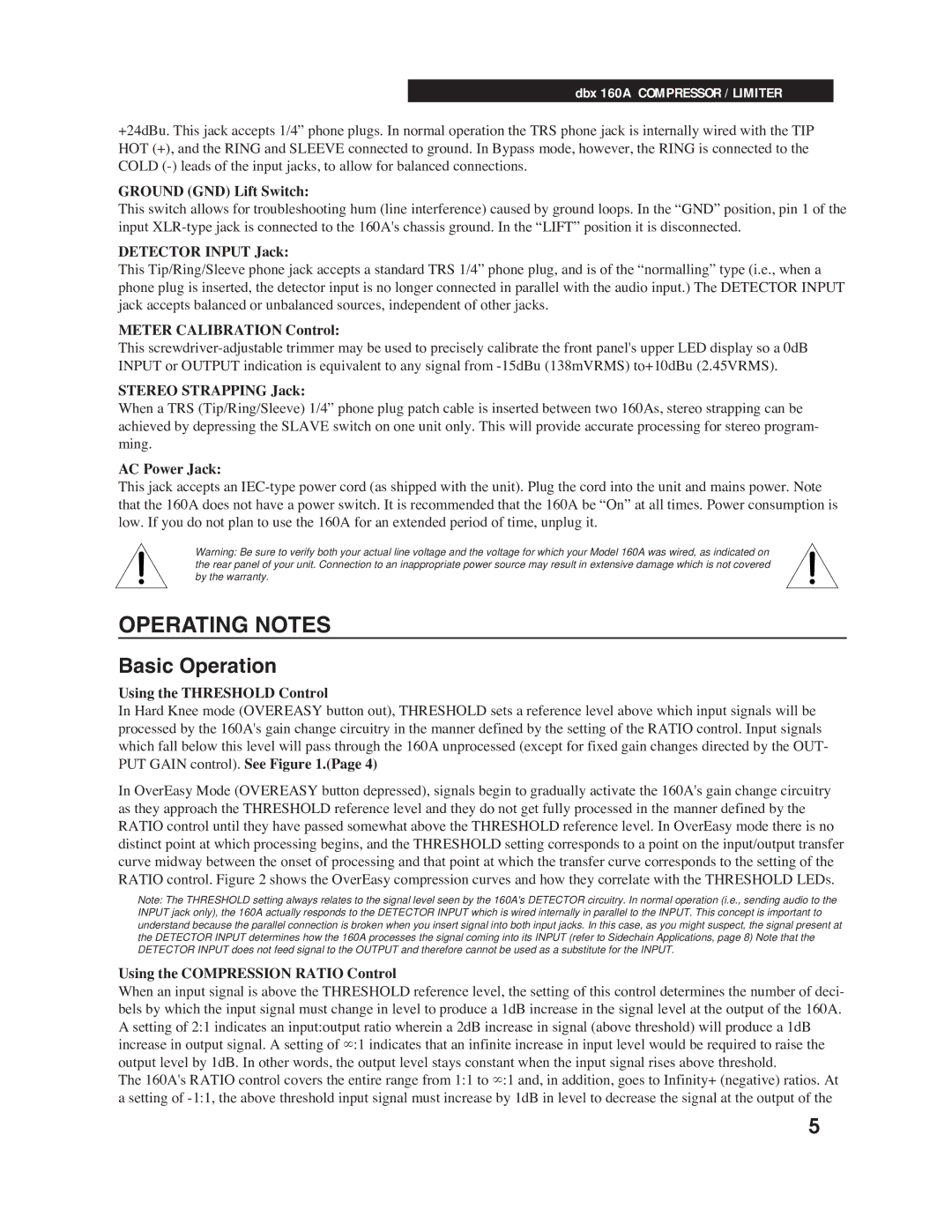
dbx 160A COMPRESSOR / LIMITER
+24dBu. This jack accepts 1/4Ó phone plugs. In normal operation the TRS phone jack is internally wired with the TIP HOT (+), and the RING and SLEEVE connected to ground. In Bypass mode, however, the RING is connected to the COLD
GROUND (GND) Lift Switch:
This switch allows for troubleshooting hum (line interference) caused by ground loops. In the ÒGNDÓ position, pin 1 of the input
DETECTOR INPUT Jack:
This Tip/Ring/Sleeve phone jack accepts a standard TRS 1/4Ó phone plug, and is of the ÒnormallingÓ type (i.e., when a phone plug is inserted, the detector input is no longer connected in parallel with the audio input.) The DETECTOR INPUT jack accepts balanced or unbalanced sources, independent of other jacks.
METER CALIBRATION Control:
This
STEREO STRAPPING Jack:
When a TRS (Tip/Ring/Sleeve) 1/4Ó phone plug patch cable is inserted between two 160As, stereo strapping can be achieved by depressing the SLAVE switch on one unit only. This will provide accurate processing for stereo program- ming.
AC Power Jack:
This jack accepts an
Warning: Be sure to verify both your actual line voltage and the voltage for which your Model 160A was wired, as indicated on the rear panel of your unit. Connection to an inappropriate power source may result in extensive damage which is not covered by the warranty.
OPERATING NOTES
Basic Operation
Using the THRESHOLD Control
In Hard Knee mode (OVEREASY button out), THRESHOLD sets a reference level above which input signals will be processed by the 160A's gain change circuitry in the manner defined by the setting of the RATIO control. Input signals which fall below this level will pass through the 160A unprocessed (except for fixed gain changes directed by the OUT- PUT GAIN control). See Figure 1.(Page 4)
In OverEasy Mode (OVEREASY button depressed), signals begin to gradually activate the 160A's gain change circuitry as they approach the THRESHOLD reference level and they do not get fully processed in the manner defined by the RATIO control until they have passed somewhat above the THRESHOLD reference level. In OverEasy mode there is no distinct point at which processing begins, and the THRESHOLD setting corresponds to a point on the input/output transfer curve midway between the onset of processing and that point at which the transfer curve corresponds to the setting of the RATIO control. Figure 2 shows the OverEasy compression curves and how they correlate with the THRESHOLD LEDs.
Note: The THRESHOLD setting always relates to the signal level seen by the 160A's DETECTOR circuitry. In normal operation (i.e,.sending audio to the INPUT jack only), the 160A actually responds to the DETECTOR INPUT which is wired internally in parallel to the INPUT. This concept is important to understand because the parallel connection is broken when you insert signal into both input jacks. In this case, as you might suspect, the signal present at the DETECTOR INPUT determines how the 160A processes the signal coming into its INPUT (refer to Sidechain Applications, page 8) Note that the DETECTOR INPUT does not feed signal to the OUTPUT and therefore cannot be used as a substitute for the INPUT.
Using the COMPRESSION RATIO Control
When an input signal is above the THRESHOLD reference level, the setting of this control determines the number of deci- bels by which the input signal must change in level to produce a 1dB increase in the signal level at the output of the 160A. A setting of 2:1 indicates an input:output ratio wherein a 2dB increase in signal (above threshold) will produce a 1dB increase in output signal. A setting of °:1 indicates that an infinite increase in input level would be required to raise the output level by 1dB. In other words, the output level stays constant when the input signal rises above threshold.
The 160A's RATIO control covers the entire range from 1:1 to °:1 and, in addition, goes to Infinity+ (negative) ratios. At a setting of
5
